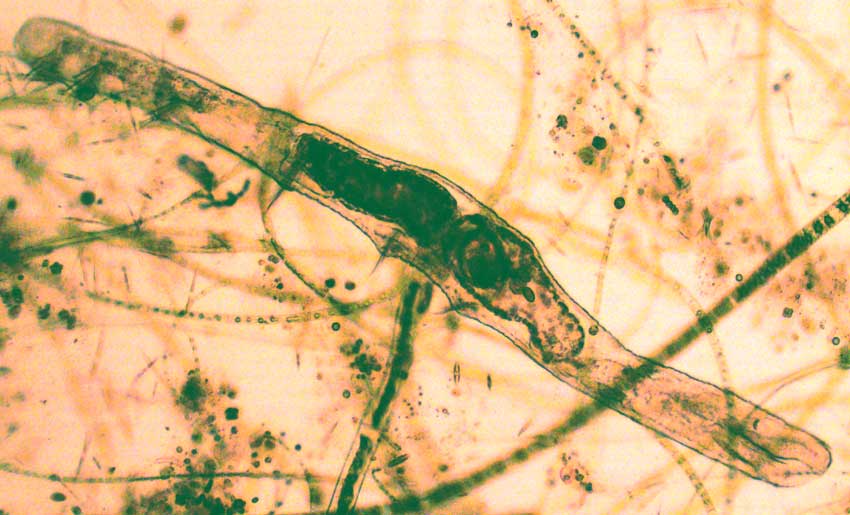Excerpts from Jim Conrad's
Naturalist Newsletter

from the March 3, 2013 Newsletter issued from the valley of the Dry Frio River in northern Uvalde County, southwestern Texas, on the southern border of the Edwards Plateau; elevation ~1750m (~5750 ft); N29.62°, W99.86°; USA
A MICROSCOPIC FRESHWATER WORM
Above you see what turned up during this week's microscopic safari into a drop of water from an inch-deep (3cm) riffle in the little Dry Frio River behind the cabin. This wormy creature was much larger than most critters we've been identifying in the Dry Frio's waters, about 1mm long (1/32nd inch), but still small enough not to be noticed unless he's on a slide with good lighting.
In the above picture notice at the picture's lower, right corner the open mouth funneling into a narrow esophagus leading to the dark, well filled stomach and intestines. Also note along the animal's lower surface the presence of short, needle-thin bristles, or setae, which appear to be serving as legs as the creature maneuvers through his jungle of filamentous algae. These setae provide an important clue as to the being's identity.
For, it's what we sometimes call a "bristle worm," a name applied to a class of segmented worms that in biology class students learn to call "polychaetes," the Class Polychaete. Polychaetes are annelids, so our aquatic, microscopic little worm is a member of the same phylum as the earthworm, the Phylum Annelida.
In general, polychaetes are thought of as typically marine, with each body segment bearing fleshy, leglike protrusions called parapodia, from which the bristles or setae arise. Therefore, our bristle worm from the Dry Frio is a little unusual for the class, since it lives in freshwater and its parapodia aren't very noticeable unless you look for them. Of the 10,000 or so polychaete species known to science, Only 168 species -- less than 2% of all polychaetes -- dwell in freshwater.
Our tiny polychaete seems to belong to the genus AEOLOSOMA, a genus whose members specialize in freshwater habitats. Several species of Aeolosoma are known, but I can't say which we have. It seems to be fairly common in the Dry Frio's shallow spots where running water passes over mossy limestone cobbles.